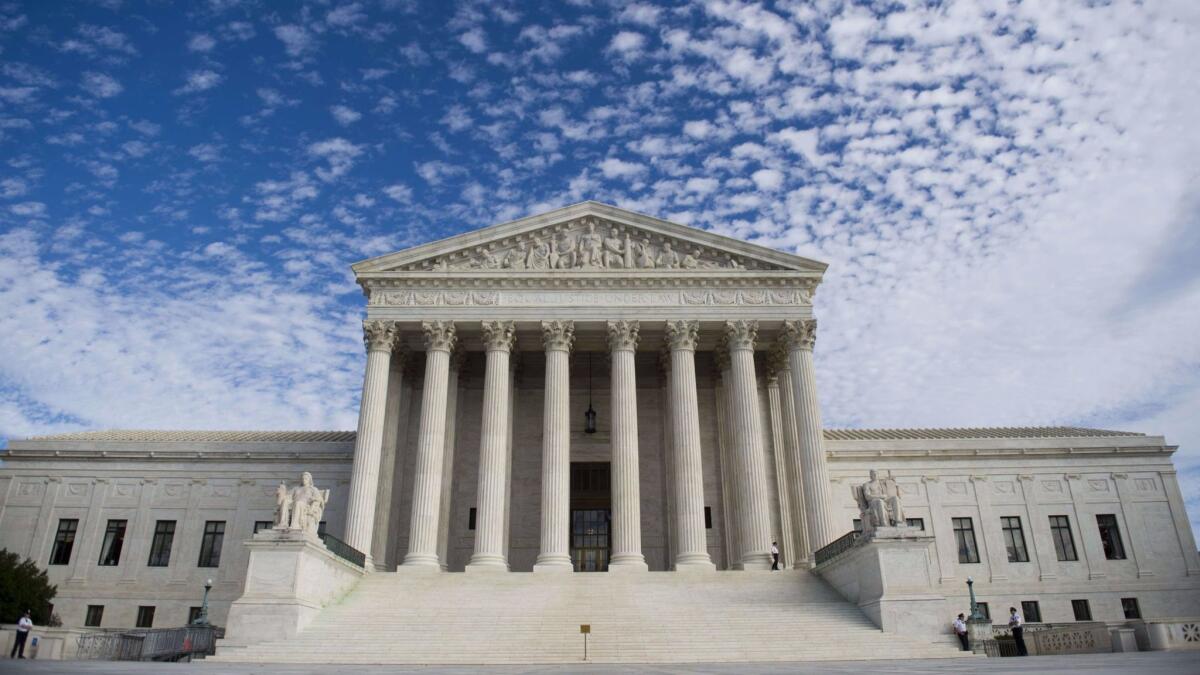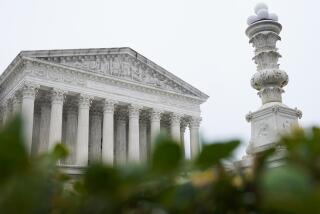Supreme Court finds the GOP packed black voters into two North Carolina districts to help win more House seats

Reporting from Washington — The Supreme Court rebuked North Carolina’s Republican leaders Monday for shifting tens of thousands of black voters into two congressional districts that had steadily elected black Democrats, striking down the move as racial gerrymandering.
The Constitution forbids a state from “separating its citizens into voting districts on the basis of race” without a compelling reason, the high court said in an opinion joined by its four liberals and conservative Justice Clarence Thomas.
The ruling is the third in recent years to fault Southern Republicans for packing more black voters into districts where African Americans were already the dominant voting bloc. By concentrating black voters into a few districts, the revised state maps strengthened the GOP’s hold in the surrounding areas.
It was also second time in two weeks the court dealt a setback to North Carolina’s Republicans. Last week, the justices let stand a ruling that struck down a 2013 law that added new restrictions on voting on the grounds the state had deliberately discriminated against its black voters.
Former Atty. Gen. Eric H. Holder Jr. hailed Monday’s ruling as a “watershed moment in the fight to end racial gerrymandering. North Carolina’s maps were among the worst racial gerrymanders in the nation. Today’s ruling sends a stark message to legislatures and governors around the country.”
The main effect of Monday’s ruling will be in the South. Under the Voting Rights Act, Southern states were pressed in the 1990s to create voting districts that would elect African American candidates to Congress or the state legislature.
Back then, civil rights advocates and liberal Democrats supported drawing these districts along racial lines as a way to reverse decades of discrimination, while the high court’s conservatives, including Thomas, were opposed.
After the 2010 census, liberals and conservatives began to flip sides on the issue. Republican lawmakers cited the Voting Rights Act as a justification for moving even more blacks into black-majority districts on the grounds they were protecting black incumbents.
Democrats and civil rights lawyers objected, arguing the Republicans were diluting the electoral clout of black voters.
Sherrilyn Ifill, president of the NAACP Legal Defense Fund, said the court had rightly recognized that disputed North Carolina districts “were clearly drawn with an intent to illegally pack as many black and Latino voters into as small an area as possible.” The decision “should send a strong signal to other states that … racial gerrymandering will be struck down as illegal and unconstitutional.”
Monday’s decision won’t settle the broader national debate over gerrymandering. Many Democrats and political scientists say Republicans have used partisan line-drawing — which is allowed under the law — to maintain a grip on the House of Representatives. They point to states such as Pennsylvania, Michigan and Ohio, where Republicans have used party affiliation to give themselves control of most of the congressional seats.
In Maryland, Democrats have drawn lines based on party membership to give them a clear advantage in all but one district.
The Supreme Court has not taken a stand against partisan gerrymandering. And Monday’s decision includes a dissent by Justice Samuel A. Alito Jr. that defends partisan gerrymandering.
“Politics and political considerations are inseparable from districting and apportionment, and it is well known that state legislative majorities very often attempt to gain an electoral advantage through that process,” Alito wrote. “While some might find it distasteful, our prior decisions have made clear that the jurisdiction may engage in constitutional political gerrymandering.”
Liberal reformers had hoped the court in the year ahead would rein in partisan gerrymandering. To succeed, they would almost certainly need to win over Justice Anthony M. Kennedy. However, he and Chief Justice John G. Roberts Jr. joined Alito’s dissent.
The North Carolina case began after 2010 when Republicans took full control in Raleigh. Previously Democrats had won seven of 13 congressional seats. After the districts were redrawn, the Republicans had a 10-3 advantage.
Two of the Democratic-leaning districts — one in the northeast and one that snaked through the middle of the state — had elected black Democrats since the 1990s. When the Republicans redrew the first district, they shifted black voters from Durham and raised the percentage of blacks from 48% to about 53%. In the central district, they added 35,000 black voters and moved out about 50,000 whites.
Civil rights lawyers and Democrats sued, and a three-judge court ruled the two districts were drawn along racial lines.
Then-Gov. Pat McCrory, a Republican, appealed, but the Supreme Court upheld the verdict.
Justice Elena Kagan said that “race was the predominant factor motivating the legislature’s decision” when it redrew the two districts. And the result was districts “with stark racial borders,” she said. Justices Ruth Bader Ginsburg, Stephen G. Breyer, Sonia Sotomayor and Thomas agreed.
Rarely does Thomas join with the court’s liberal bloc, but in this instance, he can claim to be the only member of the court who has taken the same position over 20 years. He opposed race-based districts in the 1990s, when they were intended to help minority voters, and did so Monday, when they were accused of hurting minority voters.
Justice Neil M. Gorsuch took no part in the decision because the case was argued before he arrived.
On Twitter: DavidGSavage
ALSO
Federal judges find Texas gerrymandered maps on racial lines
North Carolina voting law falls as Supreme Court turns down GOP appeal
UPDATES:
3:15 p.m.: This story was updated with additional reaction.
This story was originally published at 8:25 a.m.
More to Read
Get the L.A. Times Politics newsletter
Deeply reported insights into legislation, politics and policy from Sacramento, Washington and beyond. In your inbox three times per week.
You may occasionally receive promotional content from the Los Angeles Times.











